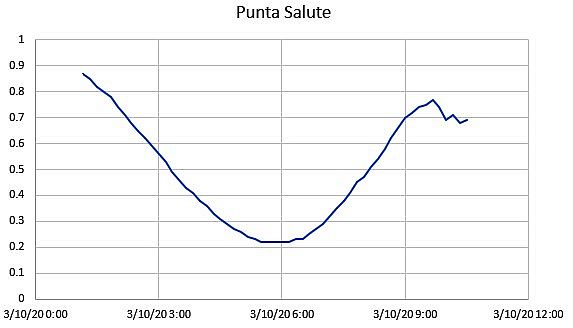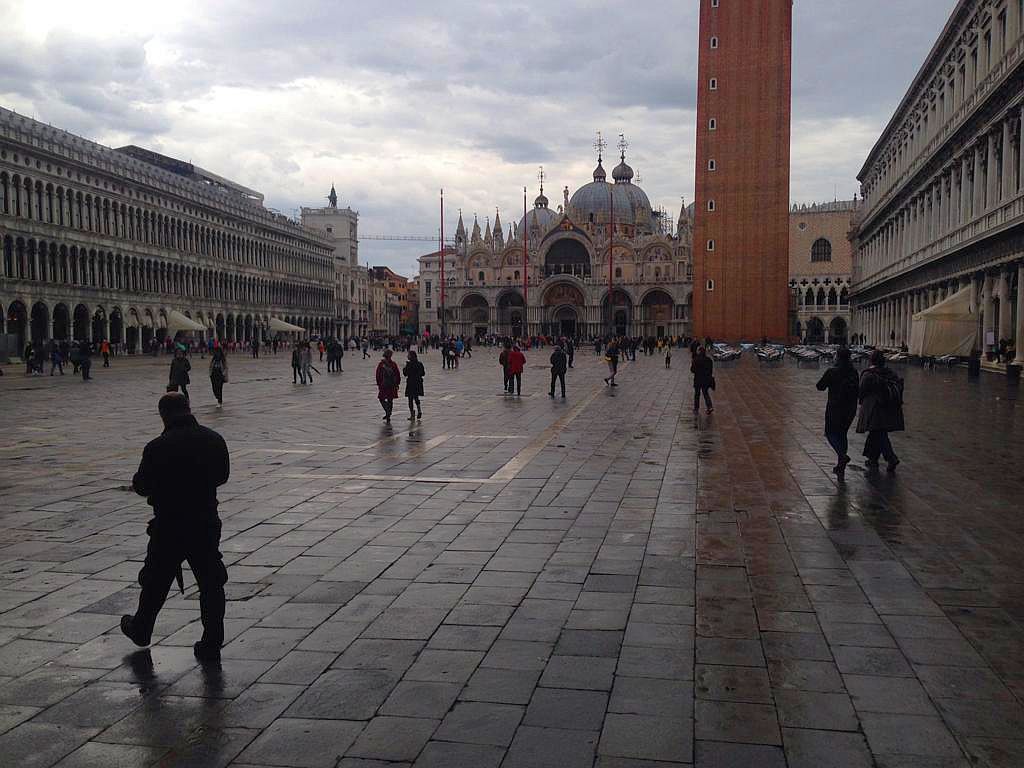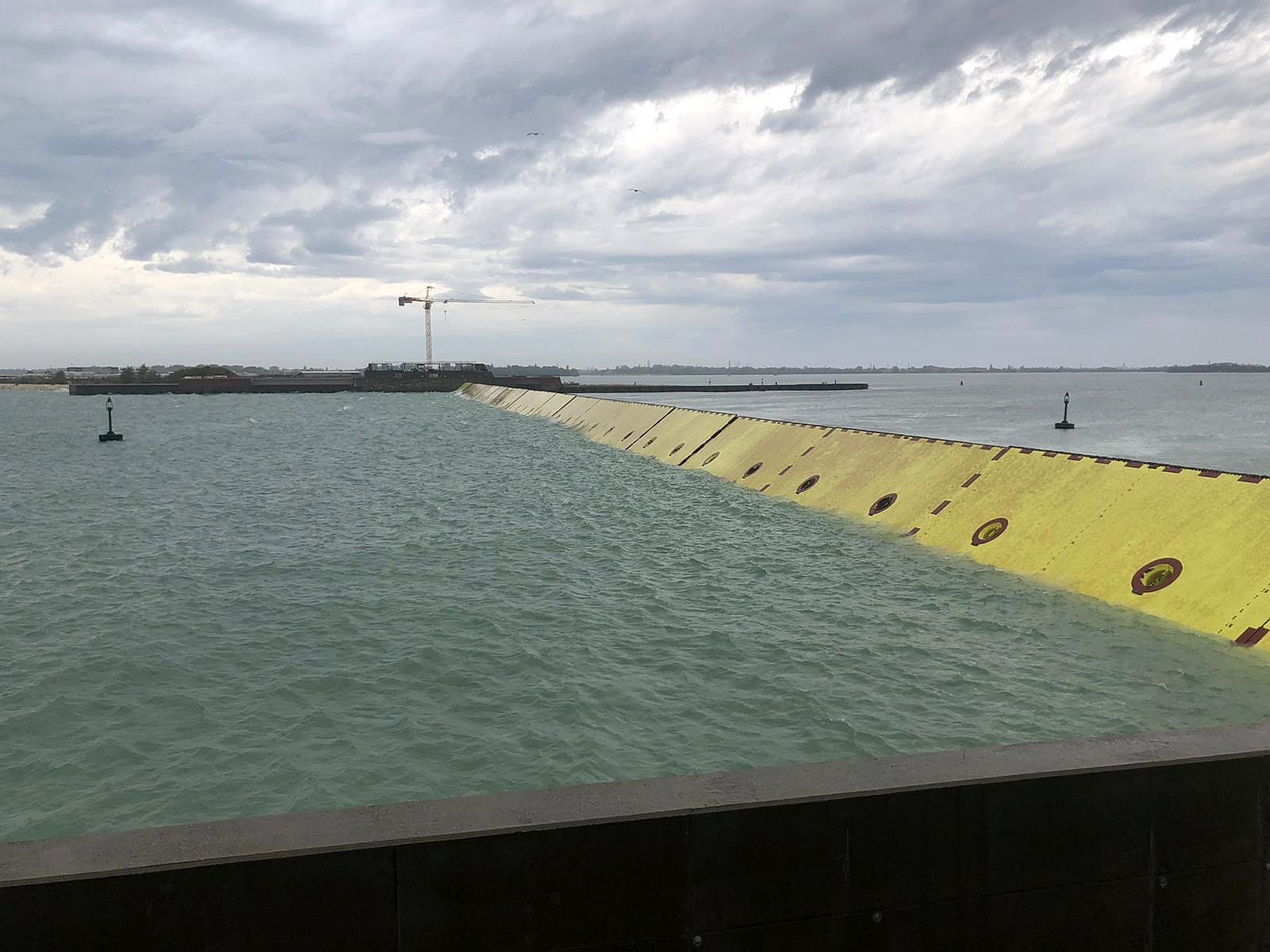I’m not going to lie: I never thought I’d see this day. Either it would never come, or by the time it did, I’d have long since turned into tera de bocal (clay for making chamberpots, as they put it here). But here we are, or more specifically, there it was this morning — the Adriatic to the right, the lagoon 70 cm lower to the left, and the vaunted MOSE floodgates ensuring for the first time that the twain shall never meet.
Years, decades, lifetimes have been devoted to constructing (and paying for) this thing, and I had little (in ErlaSpeak that means “no”) expectation that the gates would ever function. But they did. Allow me to doff my chapeau and say I’m not only astounded, but slightly weirded out. Because hearing three signals on the warning siren at 8:00 AM put all my nerves on high alert, even though we’re not in danger till four signals warn us of the possibility of the tide’s exceeding our personal domestic ground-level safe limit of 150 cm. Instead: Nothing.
I think everybody’s nerves have been a little tense, after two days of forecasts predicting an acqua alta to peak today at 135 cm above mean sea level at 12:05 PM. But at 9:00 AM (and at a mere 70 cm of rising tide) it was instead the long-discussed, -doubted, -reviled floodgates that rose, and stopped the sea at whatever the watery analogy of “in its tracks” may be. At the measuring station at the Diga Sud of the Lido the tide was at 119 cm, but the water at the Punta della Salute — bacino of San Marco, basically — was at 69 cm. When the tide turned, just after noon, it had reached 129 cm, but in the city was only a paltry 73.

We went outside to look at our canal. The water wasn’t moving. A lost pear, fallen from the fruit/vegetable boat upstream, was bobbing tranquilly in one place when it ought long since to have been carried off by the rising (or, by then, falling) tide.
Even on a normal day, the water in the canal is almost always moving at some speed, in some direction; only briefly, twice a month, does the tide pause in what is called the morte de aqua (“death of the water”). But here it was, stock still. It might as well have been in the bathtub. And so it remained until some time after the Adriatic began to withdraw; I suppose that didn’t need to be said, but perhaps someone other than myself might have forgotten that you wouldn’t lower the barrier until the sea was at least even with the level of water in the lagoon.
I didn’t used to think of 135 cm as anything more than “God, this is annoying.” But I think it’s fair to say that the doomsday inundation of November 11-12, 2019 is still too screamingly fresh in everybody’s mind to allow the casual return of “Sure, this is Venice, what do you expect?” Any tide above normal now appears potentially apocalyptic. And if our nerves were slightly on edge, so were those of the hopeful travelers who had booked hotel rooms and then, having heard early mentions of the dreaded words “acqua alta,” quickly canceled the reservations.
That’s too bad, because they missed a verifiably historic moment. And I’m glad I was here to see that pear not going anywhere in our canal.
The breakwater at San Nicolo’ on the Lido was an excellent spot for watching this epic event. This clip gives a sense of the force of the wind, always a crucial player on Team Flood Venice. This morning it was up to 41 kph (25 mph).
In case the still photograph above doesn’t convey the dynamic of what’s happening, this video from Corriere della Sera (particularly at the beginning and end of the clip) gives a glimpse of the force of the tide, as seen against the barriers as they rise, one by one. Fun fact: It took one hour and 17 minutes to raise all 78 of the gates, so the process obviously needs to start in a timely manner and not wait till the last OMG minute.


Note: Two videos, and all of the images with the exception of the water in the Piazza San Marco, were forwarded to me by friends via WhatsApp, so I am unable to give appropriate credit to their sources.


26 Comments
Totally awesome and extremely gratifying.
How wonderful to catch sight of your exhilarating post and the excellent videos so soon after you published them. Truly a historic moment and who better to write its chronicle than you?
Astonishing event. What ever the cost if it works in favor of Venice it is worth it.
I’m glad you’re glad. I just hope it continues to function; there are still loads of problems to deal with. But yes — it’s a great moment.
Great post, Erla! I never thought this day would come. I was surprisingly emotional and full of joy. You caught the feeling perfectly.
Cat Bauer recently posted..20 Films from the 2020 Venice International Film Festival – Quick Recaps
Erlamou,
Good news, and, like you, I’m surprised that Mose
actually did what it has long been meant to do. Maybe
Venezia will stay above water until we can come to see
you next year (during the Biden presidency).
I am very happy for you and all veneziani.
What a blessing for all who live and work in Venice and whose lives were negatively affected in so many ways by acqu’alta. And great news for the preservation of the city’s architectural heritage too!
“Wow!” was all I could think of. The thing works! From a strictly technically perspective it’s all good and well. Ecology and economy, important as they both may be, are both areas outside my grasp but the thing “does what it says on the tin”. I hope it will still be functional and protect Venice for a long time to come. I guess the real tests are still ahead but for now it’s really impressive to see.
Cheers!
/Andreas
Like you, all I’d heard made me feel that if it was finally pressed into action, it’d not work. Over the years of seeing the sections, rusty even before operating, and hearing the thoughts and opinions of people, I’d have had no more faith in it than you, seeing it as an expensive effort – rather like our looming HS2 rail slice through England!!
But you are a wonderful recorder, and do such a brilliant job of letting us all know what is really happening in your part of the world. Thank you yet again.
I’m so glad I have you, and others, who are so interested in Venice and curious and enthusiastic and thoughtful and all those things. You, and people like you, are what keep me on my game!
I started to cry seeing this. May it be true for the future. May it save priceless Venice!
Linda Bailey Zimmerman put me on to your blog, and I have thoroughly enjoyed your writing, not just because it is about Venice, but because you are an extraordinary observer and interpret and describe what you experience so profoundly.
I am definitely a fan.
A thousand thanks to you and also to Linda!
Finalmente. A historic day indeed.
I realize it’s only a test. But hurray!
I realize it may not stand up to global warming. But hurray!
I realize there’s a faction that says it will destroy the lagoon. But hurray!
Phooey to all that. Today we celebrate a floating pear and a harmless tide.
Praise to those who made the impossible dream possible.
Joy to all who walk the stones of the city with dry feet.
I’m so happy to know you’re so happy. Yes, it was quite the day.
Just a note: The “faction” that says it will destroy the lagoon is composed mostly of Venetians, including but not limited to Lino, people who actually know the lagoon as a living entity, not just picturesque backdrop to the city. Damage to the ecosystem has been observed since the early days of the first deepening of the inlets. This is daily, quantifiable damage, not the “damage” mooted by the faction that objects to the cruise ships for purely political reasons.
May I just mention, once again, that many interventions other than MOSE were proposed over time — less damaging, less expensive, reversible if needed. The choice didn’t have to be MOSE or nothing. But all those billions of euros to spend just couldn’t be resisted.
You know I’ve written about this many times, but let me repeat that the champions of the lagoon, few and ignored as they may be, have a very strong case. It’s just that nobody in a position to intervene cares. Nobody caring doesn’t mean they’re wrong.
I know you know all that. Just saying.
The champions of the lagoon are the quiet, steady, thoughtful, sensitive voices that the headline writers don’t really want to hear. With patience and humility, they ask us to listen to the grieving fabric of our damaged earth. Erla’s posts are standing up for their right to be heard. Which is why we should value what she writes so much.
Agree totally, Sue Boyle!!
Thank you, ladies — you have given me a real boost today!
I’m glad you mentioned that again; yes, I do know that MOSE was not the only proposal since the 1980s and may be very, very far from the best. But these days we (sorry, I should speak only for myself) take our thimblesful of joy where we can get them. One day of celebration neither invalidates nor downplays the concerns of those who take a broader and deeper view of the situation. As our esteemed governor says, quoting the state motto, “Excelsior.”
Of course I agree with you, especially on the taking-our-thimblesful-of-joy-where-we-can-get-them. I appreciate your reply. I like “Excelsior,” I think it should be everyone’s motto.
“Excelsior” In the ’50s, Volvos were pretty rare in the US. When Volvo owners would pass one another they’d wave out their respective window and greet each other with, “Excelsior, you fathead!”
Beyond fabulous. I’ll be using this a lot.
Love the Volvo story, David. Centuries ago, when I was a kid, ‘excelsior’ was a term used for thin wood shavings or paper shreds used as packaging material for mailing fragile items. Only after moving to New York, where it is the state motto, did I learn that it also meant “Ever upward!” Which may not be a bad exhortation for le barriere.
As an Erasmus student of Landcape Design in 1992 we were shown the plans of the prototype gate at the University. It’s been a long time coming! I too am thrilled at this news. And longing to visit again..
Thank you for sharing this wonderful news and video. It made my day